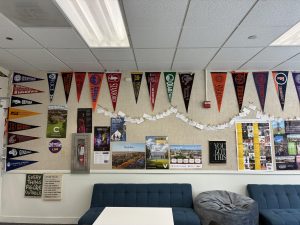Cohort C Students Worry About the Quality of Their Learning Experience
April 8, 2021
As students and teachers anxiously awaited the first day of hybrid school, those who chose to stay fully online were nervous about what school will look like for them after their teachers and peers entered the classroom. Would they be given less attention? Would they be able to participate? How could they communicate to a classroom over Zoom? Many questions and concerns crossed the minds of the full-time “Zoomers” as they prepared for the big switch. They wondered if it really is a big adjustment for them, or if the change would be simpler than they imagined.
When the district announced its return to partial in-person learning through the hybrid model, they included an option for students who did not want to return to on campus instruction. These students in Cohort AC or BC, depending on their last name, elective, or special circumstance, follow the same schedule of their in-person cohort counterparts. However instead of being at school two days a week, Cohort C continues to attend all of their classes through Zoom. At Miramonte, 78% of students chose in-person learning with the other 12% choosing to stay fully online.
For some students, the decision to remain fully online was easy because of health risks. Others were apprehensive about it because of not being in the same cohort as their friends or being adjusted to the online structure already.
“I got used to online learning over the past year, so it made more sense to me to keep my routine. So far, it has been good!” Cohort BC member and senior Ariel Steinberg said.
Before beginning hybrid, some Cohort C students were nervous about the quality of their education when their teachers are able to engage with students in person and whether they would receive equal attention and opportunities as their Cohort A and B counterparts.
“I was very nervous and worried that the switch to hybrid would negatively affect my learning experience, but, so far, I have had no reason to back that, except that it is always scary when you have to change and adjust to a new way of learning,” Cohort AC member and junior Mark Cheng said.
However, some students feel that they are not receiving the same attention as the students in class. “Most of the teachers seem to be a lot more focused on the kids that are in person. It is difficult for them to carve out time and talk to us,” Steinberg said.
For most online students, their preferred learning during hybrid schedule is discussion or lecture-based, as opposed to hands-on activities. These allow the Zoomers to equally participate in class and learn the material just as well as the students in the classroom. While they might be beneficial to students in the classroom as they allow students to physically involve themselves in the concepts, Hands-on activities present a greater challenge to understand because the online students might not fully grasp the concepts being taught as they are not experiencing them themselves.
Each classroom has an iPad that can broadcast the video of the classroom to their Zoom, as well as the teacher’s screen, which is most often projected on the projector screen at the front of the room. Some teachers have found it difficult to adjust to the new system of Zooming while teaching in-person students and worry about the quality of their teaching.
“It is hard to feel like I am adequately paying attention to both groups. Sometimes I feel like I am absolutely losing my mind. As much as we as teachers are trying our best to support everyone, I do worry about the students that are fully online feeling more disconnected than they even did previously during distance learning, and those peer to peer and student to teacher connections are so important to have a good schooling experience,” Geology and AP Environmental Science teachers Jyllian Smith said.
As many teachers are still perfecting their system of allowing the online students to listen to the class and themselves over Zoom, the online students have found it hard to hear their classmates and communicate with them effectively. This makes it even more difficult to actively participate in class discussions or activities.
“We are all listening to the same lectures and doing the same assignments, but we have to deal with technical difficulties, and it is hard to hear properly and have the same focused mentality through a computer screen,” Steinberg said.
Despite these difficulties, online school still has its perks. The Zoomers get longer lunches everyday, now extended to 80 minutes, because Academy time for most classes is devoted to in-person learners. Instead, they get their own Academy times on Mondays specific for Cohort C. Also, online students don’t have to wake up early to get ready and get to school on time. “One good part is that I get to stay in bed and wake up later. It has also been less stressful overall to continue to work at home,” Steinberg said.
As the Zoomers log out of their classes, they realize hybrid school fully online is not as bad as it seemed. Like any other adjustment, the switch to hybrid was not easy for anyone, but online students release a sigh of relief as they leave each class knowing everything is going to work out. Their teachers are supportive, and their heads are strong, so they are reassured their learning will always continue.








